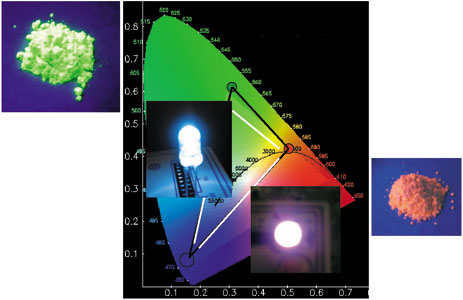Dr. R.S. Liu and Research Team Bring LED Color Closer to Natural Light
2008/10/09 | By Ken Liu | EVERLIGHT ELECTRONICS CO., LTD.Researchers at the National Taiwan University (NTU) and Everlight Electronics Co., have shed new light on LED color rendering-creating a unique phosphor-powder formula bringing the output of white light emitting diode (LED) closer to natural light than typical counterparts.
According to Dr. R.S. Liu, chemistry professor at the NTU who headed the research, the color rendering index (CRI) of the LED coated in the proprietary three-band powder is 92.2, not far from sunlight's 100, or ideally natural light, and far exceeds the 80 achieved by Nichia's YAG formula, a multi-patented science dominating the world's LED phosphor-coating market.
"I'm not the only scientist to create a high CRI formula, but succeed in mixing compounds of phosphor oxides and nitrides," Liu claims, adding that nitride compounds achieves 642-nanomter red light while the other compound 538-nm green light. And the mixture is attached to a 455-nm blue chip to emit white light.

Tests show Liu's new formula improves a high-power LED's CRI-raising it to 92.2 at 60mA from 90.5 at 20mA, while maintaining the color temperature at 5206K, with such formula having won around 70 patents.
Liu notes that some scientists have mixed sulfide and oxide compounds to achieve similar CRIs. "But such mixture has a major shortcoming: instability during even minor ambient temperature changes. And the color rendering deviation can be as high as 0.0625 on the CIE Chromaticity Coordinates as the drive current rises from 5mA to 60mA, whereas ours stays at 0.0022 at most," he says.
Whiter But Dimmer
Compared with Nichia's formula, Liu's is much more stable at high drive currents. "At high currents, Nichia's yellow YAG formula tends to turn a white LED bluish, with the current ranging between 50mA to 60mA," Liu says. However, Liu concedes Nichia's YAG formula makes an LED lamp 20% brighter than his nitride formula. "But this also motivates us to improve our formula in terms of brightness," he adds.
Liu says that Nichia still can improve on its formula's CRI-raising it beyond 80 as long as it finds ways to use phosphor powder without infringing patents.
Contracted to develop the phosphor formula for Everlight Electronics, Taiwan's No.1 LED maker, Liu stresses that bolstering phosphor technology can help put more bargaining chips into Taiwan LED makers' pockets as they negotiate cross-licensing patents with patent holders. "In the LED segment, major players like Nichia and Osram are dominating the market by building a protective wall of patents. To break down such wall by negotiating with big players to license their patents, Taiwan-based manufacturers need to hold more bargaining chips-which is to prove themselves by achieving higher tech superiority," he notes.
Unrealistic Expectation
An authority on the phosphor field in Taiwan, Liu laments that Taiwan manufacturers harbor an unrealistic dream: looking to him to develop an omnipotent phosphor formula. "Even if such formula exists, these manufacturers would be unwilling to invest in the R&D. I believe a manufacturer does not necessarily have to specialize in all phosphor technologies, but should retain individual focus. Also by swapping specializations the makers can enlarge the market, as well as reduce R&D costs," he comments.

Earning a Ph.D. on high-temperature superconductivity at Cambridge University in Britain after receiving an MSc in semiconductor element analysis from the elite National Chinghua University in Taiwan, Liu, before heading to Cambridge, worked at the government-backed Industrial Technology Research Institute (ITRI) as a senior research scientist to develop semiconductor compounds and formula. "I introduced Taiwan's first GaP-based red LED and am one of the few specialists in Taiwan with backgrounds in both semiconductor compounds and high-temp superconductivity," he claims. Liu, besides having trained many specialists for Taiwan's LED industry over the years, is working to boost the stability of silicate-type phosphors.




